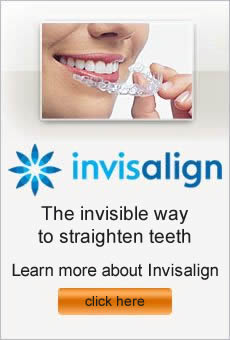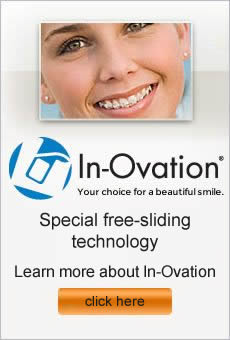If you’ve just had braces applied, oral hygiene as you know it is about to change. You can’t keep on with your oral routines in the same fashion that you did prior to braces, or you’ll open yourself up to bacteria and gum disease, possibly even cavities. Along with regular checkups and cleanings, you’ll need to have good habits at home.
Braces need extra care. They’re bulky and they trap food in ways that will surprise you. Each time you brush, be prepared to see lots of food debris in your sink when you spit, and you can be certain that if you’re only brushing, you’re leaving behind even more food debris.
When you have braces, it’s recommended that you brush following every meal, not just twice a day. If you can’t brush, it’s essential that you rinse out your mouth and spit several times to clear out as much remaining food as possible. Brush gently around each bracket, first angled up along the gumline and bracket and then again along the top line of the bracket. Don’t just scrub, but be gentle and persistent, for a minimum of two minutes.
Flossing is a big challenge with braces. It takes more time and more effort. The floss must be threaded up, between each bracket and beneath the wire, threading it so that you can get the floss between each tooth. This must be repeated for each bracket in your entire mouth.
After flossing, you can use a rinse of half hydrogen peroxide and half water. Swish it in your mouth and allow it to penetrate the areas you’ve opened up with brushing and flossing. You’ll see the bubbles working! This can be a major help in maintaining gum health while wearing braces.
Talk to Sherman Oaks orthodontist Dr. Fotovat for extra tips on keeping your mouth fresh and clean while wearing braces so that when your braces come off, healthy white teeth are waiting for you.
From crooked to protruding teeth, to much more difficult dental problems, orthodontia can effectively correct a wide array of issues. Whether your teeth are widely gapped, overly crowded, or oddly placed, your orthodontist can recommend a teeth straightening option that will fix your crooked smile. Some of the issues that can be corrected with orthodontics include:
- A jaw that is not large or wide enough for the teeth to emerge, causing crowding of the teeth
- Teeth that have excessive space between adjacent teeth which creates gaps
- Malocclusions, or bite issues, caused by teeth or jaws that are misaligned and do not fit together the way they are intended to align
- Upper teeth that extend too far forward, or lower teeth that do not sit far enough forward
- Overbite caused by upper front teeth that stick out over the lower front teeth
- Underbite caused when the lower jaw pushes out, leaving the lower front teeth to rest in front of the upper front teeth
- Openbite, often a result of thumb sucking or tongue thrusting, which keeps the front teeth from overlapping or meeting as the bite closes
- Upper teeth that sit inside the lower teeth, causing crossbite
These dental problems not only affect the appearance of your smile but the functions of your teeth. Left untreated, these conditions can cause issues such as damage to tooth enamel, jaw discomfort or injury, and chewing or speech problems. A consultation with a qualified orthodontist can help you determine what type of orthodontic treatment will best address your specific oral problems. With orthodontic treatment, you can correct these issues and walk away with a more perfect, beautiful smile.
If you are looking for an orthodontist in Sherman Oaks, contact our office today!
If you are seeking treatment for crooked or misaligned teeth, one of the most appealing options available today is Invisalign. This innovative way to improve your smile utilizes a set of custom trays, called aligners, to correct and straighten teeth. Conventional treatment with metal braces can be uncomfortable, painful, unattractive and inconvenient. Treatment with Invisalign has many benefits when compared to other straightening methods, including:
Invisalign braces are hardly noticeable because the aligners are clear. If you would rather not sport the “metal mouth” look, Invisalign would be an excellent choice.
Invisalign braces are more comfortable than metal braces because the aligners can be removed when needed. Traditional braces are permanent until removed by your dental professional, but Invisalign trays can be taken out to eat or drink or for other brief periods of time as necessary.
Invisalign braces are safe and do not utilize wire and metal that can scratch and puncture the mouth or gums. The clear aligner trays are smooth, with no sharp edges.
Invisalign braces make cleaning your appliance and your teeth and gums a snap. Because the aligner trays are removable, they are easy to take and out clean, and then allow you to brush and floss your teeth normally.
Invisalign braces usually require shorter treatment time than traditional braces. Metal braces may take up to 5 years to complete treatment, but treatment with Invisalign generally takes 1 to 2 years.
The advantages of Invisalign are many, and lots of patients are excellent candidates for treatment with the clear aligners. If you are considering orthodontic treatment to correct your imperfect smile, consult with a dental professional to find out if Invisalign would be a good option for your specific needs. With Invisalign, you could quickly and easily be on your way to a more perfect smile.
We all think of braces as a rite of passage for middle school kids, maybe high school students, but it’s not something we commonly associate with adults. Many more adults, however, are turning to braces to correct problems that have bothered them for years, possibly since childhood. Adults who grew up being teased or embarrassed by their smiles can turn into adults who have difficulties getting close to people, something that can affect them personally and professionally. Fortunately, braces can help.
Braces can correct a host of oral issues, from simply poor aesthetics due to crooked teeth or an acutely bad bite (known as malocclusion). Adults who didn’t have the ability to change their teeth as children now turn to braces to make positive changes to their smiles and achieve their long-awaited dreams.
Adults and children respond differently to braces. Because a young person’s mouth is still growing and changing as part of aging, braces work more quickly on younger patients. Adults can achieve the same kind of smile successes as children can with braces, but it will just take a little more time due to their bones being already fully formed.
Adults typically care for their braces more than young people. A higher appreciation of the dangers of neglect and improper care can lead an adult to take far better care of his or her oral hygiene than a younger patient with braces.
Some types of braces are available that are less obvious than external brackets, such as ceramic brackets or lingual braces (worn on the inside of the arch of your teeth) or Invisalign aligners. Ask your orthodontist what braces options are available to you as an adult, and what positive changes they can make to your smile.
Orthodontist in Burbank CA
Traditional braces have long been thought to be the only option available to straighten your teeth and correct your bite issues. Advances in Invisalign aligners now give you a choice, one that might just leave your mouth healthier when all is said and done.
Invisalign aligners are clear plastic trays that are worn for up to twenty-two hours a day. They can be removed while eating and for cleaning. A series of trays is prepared to slowly guide the teeth into proper position over time. When one tray has done its job, the next tray in the series is utilized.
Traditional metal braces are extremely challenging to clean. The brackets and bands trap bacteria and food debris all around the teeth, and in order to prevent gum disease and cavities, wearers must thread floss painstakingly under each wire and floss each tooth one-by-one, threading again and again. Brushing is challenging, too, as brushes wear out very quickly and can’t always reach the difficult areas. Even using a waterpick can’t be fool proof, because if used incorrectly, bacteria and debris are simply pushed further into the gum pocket, causing irritation and leading to infections.
Invisalign allows you to take out your trays so you can brush and floss normally, just as you did before you began your treatment. Trays are rinsed with water and placed back in the mouth. The teeth are clean and the aligner is clean, all in a fraction of the time it would take to clean a mouthful of traditional braces.
Keep your mouth healthier by talking to your orthodontist today to see if Invisalign aligners are right for you and your smile goals.
If your child just got braces, you will need to watch closely to ensure that all of the proper steps are being taken to ensure that when the braces come off, your child is left with a mouthful of healthy, straight teeth, not a mouthful of cavities and gum disease!
Oral hygiene is more complicated and involved with braces, and a child who already has good habits is going to be challenged to step up to the new routines. Brushing and flossing can be far more difficult with braces and can take twice as long – or longer! You may not have watched your child brush in years, but now is the time to start paying attention again.
Your child’s orthodontist explained the new routines to your child as part of the braces application, but after the “new” wears off, the excitement and the sense of urgency to brush and floss can dissipate, and bad habits can be developed. Your child’s first in-office cleaning could bring some surprises, as children who never had a dental problem might be faced with plaque buildup or infection in the gums. Some dentists recommend that children have cleanings every three months instead of every six while braces are in place because extra care is needed.
If your child isn’t caring properly for his or her teeth while wearing braces, you will need to be firm about good habits. Be certain that your child understands what could happen if bacteria takes hold. Formerly healthy teeth could need fillings or other repairs. Consider setting up a reward system for good or improved checkups. Pair brushing with a reward chart and stickers and give small treats for a week’s worth of good habits.
Some dentists have special, colored toothpastes available that enable your child to see exactly where plaque is hiding. These toothpastes leave green or blue behind until the brushing process is thorough and complete. Your child might think it is fun to have a green mouth and would find brushing much more interesting.
If you’re having trouble getting your child to brush and floss while wearing braces, talk to your child’s orthodontist in Sherman Oaks for more tips.



